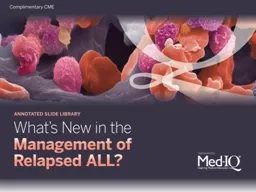

MSc University of Tennessee College of Health Sciences Memphis TN Learning Objectives Upon completion participants should be able to Review treatment regimens for patients with relapsed ALL ID: 734739
Download Presentation The PPT/PDF document "Activity Faculty Scott C. Howard, MD," is the property of its rightful owner. Permission is granted to download and print the materials on this web site for personal, non-commercial use only, and to display it on your personal computer provided you do not modify the materials and that you retain all copyright notices contained in the materials. By downloading content from our website, you accept the terms of this agreement.
Slide1Slide2
Activity Faculty
Scott C. Howard, MD,
MScUniversity of Tennessee College of Health SciencesMemphis, TN
Slide3
Learning Objectives
Upon completion, participants should be able to:
Review treatment regimens for patients with relapsed ALLOptimize supportive care for patients who receive relapsed ALL therapy
Slide4
Key Considerations in the
Management of Relapsed ALL
Slide5
ALL
The incidence of ALL is highest among children and decreases with advancing age
Most common form of leukemia in childhoodOnly one-fifth of leukemia cases in adultsRoughly 80% of patients treated with risk-adapted therapy at diagnosis are cured
However, outcomes for patients with relapsed disease are poor
PRACTICE PEARL
Relapsed ALL (except for late extramedullary relapse) has a poor prognosisSlide6
When to Suspect Relapsed ALL
In general, relapse should be suspected in patients with any of the following:
New neurologic deficitsTesticular massCytopenias of unexpectedly long duration and severity during therapyBlasts noted on the peripheral blood smear or in the CSF
It is essential to confirm relapse before initiating salvage therapy
Slide7
Initial Steps for Patients With
Suspected Relapsed ALL
Confirmation of the relapse is essentialFlow cytometryPCR assays
Slide8
Initial Steps for Patients With
Suspected Relapsed ALL (cont.)
Identify site(s) of relapseBone marrow (isolated vs. combined)CNSTestesOther extramedullary sites
Slide9
Factors Affecting Risk Stratification
in Relapsed ALL
Time to relapseSite of relapseImmunophenotypeResponse to initial therapy for relapse (ie, MRD after 2 blocks)
Slide10
Defining Risk-Based Groups for Reinduction Therapy
Standard-risk treatment group: HSCT not necessary
Late relapse (≥ 36 months from initial diagnosis), ANDB-lineage ALL,
ANDMRD ≤ 0.01% after 2 blocks of induction therapy
High-risk treatment group: HSCT if possible
Early relapse (< 36 months from initial diagnosis),
OR
T-lineage ALL,
OR
MRD > 0.01% after 2 blocks of induction therapy
Slide11
Reinduction
Therapy for
Standard Risk Relapsed ALL*Regimens usually include high-dose methotrexate and high-dose cytarabine.
PRACTICE PEARL
All known-effective agents should be used at
first relapse to get the patient into a deep remission before transplant or continuation
Intensive chemotherapy with radiation in some cases
Late isolated
non-CNS
extramedullary
relapse (
eg
, testicular)
Intense relapsed induction chemotherapy regimen* followed by consolidation and continuation
Bone marrow
relapse
Intense systemic
and intrathecal chemotherapy* with cranial (or craniospinal) radiation
Late isolated
CNS relapseSlide12
Reinduction Therapy for High-Risk Relapsed ALL
Standard reinduction regimens are not sufficient for patients with high-risk relapsed ALL
PRACTICE PEARL
All known-effective agents should be used at
first relapse to get the patient into a deep remission before transplant or continuationSlide13
Investigation Into Novel Reinduction Regimens Is Ongoing
Current phase 2 study at St. Jude Children’s Research Hospital (NCT01700946)
Examining new approaches to achieve deep remission as early as possible following relapseStratifying patients into risk groups to define treatment approach
Chemotherapy for standard riskChemotherapy followed by HSCT for high risk
PRACTICE PEARL
All known-effective agents should be used at
first relapse to get the patient into a deep remission before transplant or continuationSlide14
Reinduction Therapy for High-Risk Relapsed ALL (cont.)
Once CR2 is achieved, initiate intensive chemotherapy followed by HSCT as soon as MRD-negative status is achieved
Recommend HSCT to those with high-risk featuresHSCT may be appropriate for some intermediate-risk patients in CR2
If no stem cell donor is available, proceed to consolidation and continuation therapy, as is done for standard-risk ALL
PRACTICE PEARL
All known-effective agents should be used at
first relapse to get the patient into a deep remission before transplant or continuationSlide15
Relapsed ALL Treatment Algorithm
Marrow not involved
Marrow involved
Enroll in a clinical trial
Early relapse or
T-lineage ALL or
MRD > 0.01% after initial therapy
Late relapse and
B-lineage ALL and
MRD ≤ 0.01% after initial therapy
Standard risk
MRD measurement
Suspect relapse
(New neurologic deficit, blasts on blood smear or
in CSF, prolonged cytopenias during therapy)
Confirm relapse and identify sites of disease
(BMA; neurologic, testicular, and CSF examinations)
Regimen for isolated extra-medullary relapse
Risk stratify
High risk
Induction Block II
Induction Block ISlide16
Relapsed ALL Treatment Algorithm
SCT
Continuation
MRD
≤ 0.01%
MRD
> 0.01%
MRD improved
No
SCT donor
MRD worse
Consider palliative care
Consider experimental therapy
Consolidation I
Consolidation I
Consolidation II
Intense block of chemotherapy
Standard risk
High riskSlide17
Preventing Toxic Death
in Relapsed ALL
Management of febrile neutropeniaEmpiric antimicrobial therapyInpatient admission
Antifungal prophylaxis Consider for all patients receiving chemotherapy
Administer until at least day 75 following
allogenic
HSCT
Avoid
antifungals
that inhibit
cytochrome
P450 3A4
isozyme
PRACTICE PEARL
Great supportive care is as important to
optimal patient outcomes as chemotherapySlide18
Key Considerations in the
Management of Relapsed ALL
Slide19
Thank You!
©
2014 Med-IQ. All rights reserved.